First published
“The year 2018 has been a crucial year in the development of China’s Social Credit System (社会信用体系),” lawyer Ju (居小森律师) writes on Weibo this week.
The past year has indeed been the year of China’s Social Credit System: it was an important year for the system’s implementation, and it also became one of the most discussed China-related news topics in international media1 – using sci-fi vocabulary, powerful emotional words, suspenseful music, and dramatic images in their SCS-focused stories, the SCS is presented much differently in Western media than it is within the PRC.
SCS: From Google to Weibo Trends
From October 2017 to October 2018 alone, the Google search engine comes up with more than six million results in a search for the term “China social credit system” in English. Showing all results from before this time, there are 160 million results for the term in total.
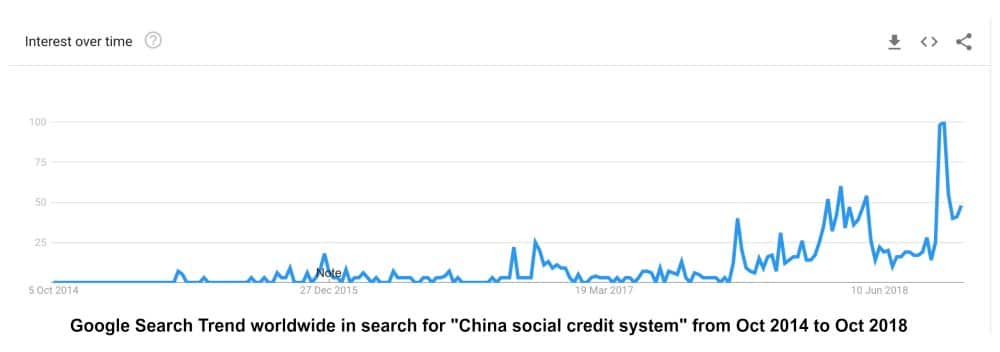
(whatsonweibo/google)
Google Trends statistics show that worldwide interest in China’s Social Credit System had its absolute peak in the past year, and that Black Mirror, the British science fiction series exploring the dark consequences of new technologies, is one of the terms that is most associated with the web search query ‘China’s social credit system.’
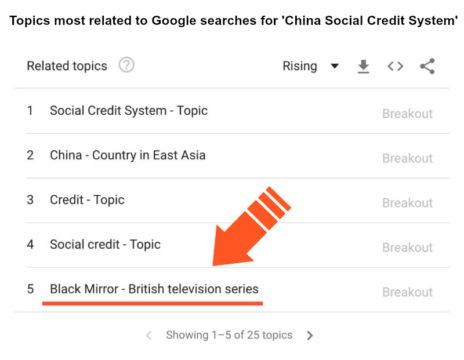
Black Mirror is a highly popular series on Netflix, of which one 2016 episode called ‘Nosedive’ revolved around a dystopian society where people are judged by a numeric rating given to them by their interactions with other people, affecting their opportunities in life. This episode is often connected to China’s SCS by Western blogs or news sites.

In the Black Mirror episode ‘Nosedive’, people’s position on the social ladder is determined by other people ranking them.
The Black Mirror association with ‘social credit’ does not only come up on Google Trends. On Twitter, for example, some of the hashtags most related to the term also includes “#blackmirror.”
In contrast to the English term, with 160 million results, the Chinese term for the social credit system (社会信用体系) comes up with only 19,2 million total search results on Google. Google Trends also shows a rather minimal interest in the Chinese term compared to its English equivalent.
Although that result is somewhat flawed (the Google search engine is blocked in mainland China), Baidu, one of China’s most popular search engines, also gives a comparatively small total of 7,7 million results for the same Chinese web search query.
All in all, there are clear indications that the attention for the Chinese Social Credit System in the international English-language online media environment is much bigger than that within China.
While the Social Credit System (SCS) is being mentioned on Twitter almost every five to ten minutes at time of writing, it is only being discussed on Weibo with intervals of minimally one or two hours by posts that are barely getting likes or comments.2
This is especially noteworthy when considering that Sina Weibo has around 100 million more monthly active users (±430 million) than Twitter has (±326 million).
So what does this all mean? How come that there is so much appetite for this topic outside of China, while inside the PRC, where the ‘system’ is well underway, there is a lesser public interest in its development?
What Actually is the Social Credit System?
In the book Social Credit Law: Principles, Rules and Cases, author Luo Peixin explains Social Credit as follows:
“Social Credit is a management system that takes big data as its basis, is supported by technological capacities, and is backed by law [legal provisions]; it is an important modern method to forward the country’s governance systems and management capabilities” (3).
Rather than one system or database, the Social Credit System is an overall policy or ideology, a mechanism of punishments and rewards, that is allegedly “meant to improve the integrity and trust level of the whole society” (creditchina.gov.cn).
In 2014, the Chinese government announced its first plans on the construction of a nationwide Social Credit System to be rolled out by 2020. For now, there is not one system in place, but rather a collection of different implementations and experiments across various regions and cities across China.
What they all have in common, though, is that individuals, corporations, or agencies are being assessed based on their ‘trustworthiness’ (Kostka 2018, 1).

In Shaanxi’s Ankan city, blacklisted trust ‘offenders’ are being publicly displayed on a local court’s LED screens this month (via http://jszx.court.gov.cn).
The past summer has seen some important developments in the realization of a national Social Credit System. In the Chinese state media article “The Credit Society is Coming, Are You Ready for It?” [“信用社会来临,你准备好了吗”], People’s Daily notes that new Social Credit terms such as “blacklists” (黑名单) will become more ubiquitous in daily life from now on.
Earlier this year, the first names on the ‘lose trust list’ (失信人名单) – meaning those who have failed in complying with their public commitments or court orders – were reported to the Chinese railway and aviation departments by the China Securities Regulatory Commission (CSRC) to block these people from traveling.
At the beginning of 2018, twelve cities have been announced as successfully laying out the foundations of a Social Credit management system.3
Other Chinese cities are frequently added to the ‘credit cities’ list. Dalian, for example, is one of the cities that is highlighted by Chinese media this month for “steadily advancing” its Social Credit System implementation. The city has introduced an automated administrative process at its Public Resources Trading Center, in which people who are found to have bad credit will automatically be refused the handling of business.
It is just one among dozens of examples of how various cities and regions in China are experimenting with Social Credit and both punitive and rewarding measures.
Besides the SCS initiatives being implemented by local governments, commercial companies are also participating in making China a more credit-based society. Users who opt in to Alibaba’s Sesame Credit loyalty program system, for example, can enjoy many benefits if they have a good credit score (650+), such as borrowing books from the local library for free, or using share bikes without deposit (more on Sesame Credit and its perks here).
According to Weibo user ‘Lawyer Ju’, the broad credit system “covers both economic credit systems and social integrity systems,” within which the blacklist system is getting “more and more important”, adding that “the joint structure of ‘lose trust in one place, and there’s no place to go’ [一处失信、处处受限] will soon be here.”
Weibo Focus: No Bad Deed Should Go Unpunished
Lawyer Ju is not the only Weibo user who seems rather optimistic and happy about the implementation of a system that governs society based on trust.
Although major discussions on the actual ‘Social Credit System’ – using that exact term (社会信用体系) – are practically non-existent on Weibo, there are other examples of trending topics linked to the system that have gone viral lately.
One noteworthy example is the topic of two ‘Train Tyrants‘ that went trending on Chinese social media since August of this year.

The two train bullies that went viral the past months.
It all started with the “Highspeed Train Tyrant” (高铁霸座男) in September. It is a nickname that was given to a man who refused to give up the seat he took from another passenger on the G334 express train to Beijing in late August, and whose bizarre and rude behavior was caught on video.
The other train bully that went viral in September, is a woman from Hunan who was dubbed ‘High-Speed Train Tyrant Woman’ (高铁霸座女) by Weibo netizens.
She had taken a seat assigned to another passenger while riding the train from Yongzhou to Shenzhen. A video (YouTube link here) shows how the woman makes a scene when the train conductor tells her she is in the wrong seat; she refuses to get up, raises her voice, talks rudely to the conductor, and simply claims she has bought a ticket and will not change to another seat until she has reached her final destination.

The story of this female ‘train tyrant’ became trending on Weibo with over 500 million views.
With more than 600 million combined views on the stories of the highspeed ‘Train Tyrants’, making them one of the bigger news stories of the year, the unruly behavior of passengers on Chinese public transport system made headlines. When news came out that both ‘bullies’ were fined and blacklisted by the Chinese railways (banning them from boarding trains for 180 days, see this article by Jeremy Daum for more on the legal aspects), many commenters applauded the system – although some deemed it not punitive enough (“180 days and a 200 yuan [$28] fine is nothing!“).
Although this case concerned a Railway-specific blacklist, many people commented that this blacklisting system should also be applied to people disturbing the order in hospitals, for example, and that it should be linked with the nationwide Social Credit System.
Moreover, many deemed that the Social Credit System should be even more punitive to people disturbing the public order, saying they “only had themselves to blame” (“咎由自取”), and it is a mere matter of “how karma works.”
Twitter Focus: China’s Scary Social Credit System
Meanwhile, on Twitter, a very different Social Credit story is going viral. A two-minute short video published by the Economist on October 26 titled “How Does China’s Social Credit System Work?” has more than 275,000 views on Twitter alone at time of writing (Update 23.00 China time: Economist has removed the video within hours after this article was posted).
Accompanied by suspenseful music, the video starts by captioning that by 2020, “the Chinese government will give all 1.4bn of its citizens a personal score based on how they behave.”
It further alleges that the ‘system’ will “track people’s activities on the Internet,” and that “what they buy, view, and say online will all be analysed,” followed by the claim that “this data will then be evaluated and distilled into a single number according to rules set by the government.”

Still from the Economist video.
The Economist video then focuses on surveillance cameras “that track people’s behavior in public”, suggesting that someone’s “score” could be lowered by crossing a red light, and that 12 million people have already been “punished for having a low score” through domestic travel bans.
Among thousands of reactions on the video, many compared China to an “Orwellian surveillance state” or a “Black Mirror episode.”
This recent Economist video is but one of dozens of examples of international media outlets describing China’s Social Credit System within a certain framework, mainly linking it to terms such as ‘punishment,’ ‘surveillance,’ and ‘individual scores.’
Many of these news stories suggest that every Chinese citizen will be assigned a ‘score’, or that people’s mere way behaving in public will be able to lower that ‘score’, resulting in ‘punishment’ (FYI: there is no indication that there will be one ‘score’ for citizens in a nationwide SCS, also see this article).
These stories are often grossly conflating the (optional) commercial credit systems, such as Sesame Credit, with national government policies and local experiments. (For more about this, also check this article).
Dramatically Different Approaches
By just comparing the previously mentioned examples of the Train Tyrant viral story in China, and the Economist viral video, one can get a glimpse of the great gap in (social) media approaches of the Social Credit System in China and in Western media.4
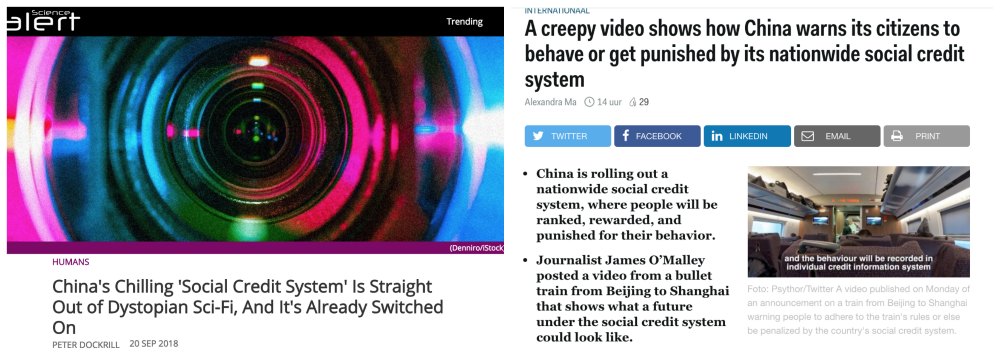
“Creepy”, “Chilling”, “Sci-fi” – some of the words used in Western media headlines to frame the SCS.
In the international media headlines, powerful emotional words like ‘chilling’, ‘creepy’, or ‘dystopian’ are often used. Perhaps not coincidentally, marketers since long know that readers react more strongly to ‘alert words’ that make us feel anxious, such as ‘afraid’, ‘scare’, ‘risk’, and ‘alarm’ – which are all great words to get more engagement with social media users, and thus will result in more clicks.
As ‘sexy’ as the SCS might seem in Western media, as ‘dry’ it can seem in the Chinese media context, where the most powerful words used in headlines are terms as ‘trust’, ‘harmony’ or ‘blacklist’, and where there are no dramatic images; occasionally there is a featured photo of officials having a meeting (to see more on how state media propagates the SCS through cartoons, click here).

A typical SCS-focused article in Chinese media.
This difference in the framing of SCS between Western publications and Chinese articles can also be seen in the specific words used in SCS-focused news stories.
The word clouds below show the most used words in three typical SCS articles from Western mainstream media (Independent, Guardian, and ABC), and three typical English-language Chinese state media articles on SCS (namely Global Times, Xinhua, and China Daily ).
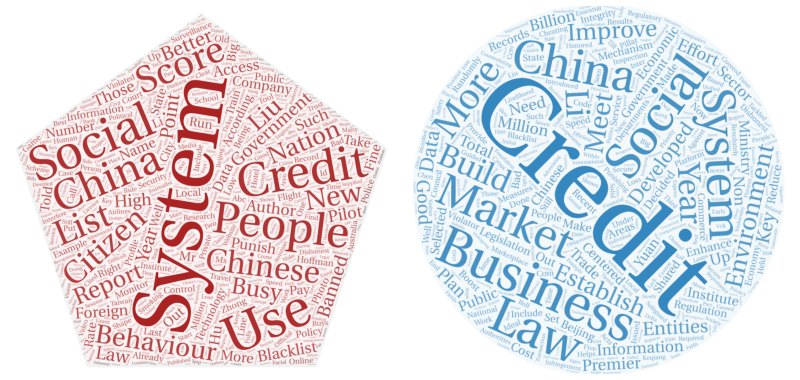
Most common words in news articles discussing the social credit system in Western media (left) and English-language Chinese media (right). (By What’s on Weibo via wordart).
While there are many words overlapping between the two examples, the most-used words in these Western media sources (left) are words as ‘system’, ‘list’, ‘citizen’, ‘behaviour’, ‘score’, and ‘government’, whereas the Chinese state media sources (right) more commonly use words as ‘business’, ‘law’, ‘market’, and ‘build.’
Doing the same experiment with Chinese-language state media articles on the SCS (Sina News, People’s Daily, and Guangming Daily) shows that ‘trust’ or ‘credit’ (信用) and ‘building’ (建设) are among the most-used words, with terms such as ‘enjoy together’, ‘cooperate’, or ‘unite’ frequently popping up.
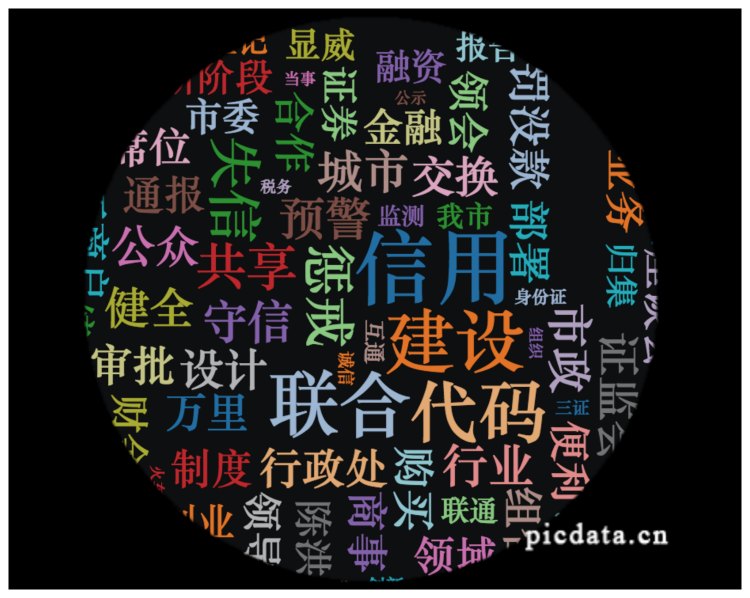
The result of the most common words used in three state media articles on SCS (Whatsonweibo via Picdata).
The different public attitude towards the SCS implementation in China versus the Western media discourse on the issue, is also illustrated in a recent study by Genia Kostka (2018), that investigates Chinese citizens’ attitudes towards social credit systems. Rather than thinking of it as a ‘creepy’ or ‘dystopian’ system, it showed that SCSs actually have very high levels of approval across the respondent groups in the study (her work can be viewed here).
Social Credit Accounts without Followers
Ever since the 2014 plans of China’s Social Credit implementation were announced, Chinese social media has seen dozens of regional, urban, district-based ‘Social Credit’ accounts pop up on Weibo and WeChat to inform netizens of local developments.
The online presence of these local social credit programmes signals that Weibo and Wechat may have hundreds of these accounts in the future informing citizens/netizens of new measures and guidelines.
However, the fanbase numbers of these accounts, again, reflect that there does not seem to be that much interest for the nascent SCS implementations.
A brief overview of some of these Weibo accounts:
* Credit Suzhou @苏州工业园区信用平台
Followers: 391
First post on record: September 29, 2015
* Liaoning Credit @信用辽宁
Followers at time of writing: 764
First post on record: August 1, 2012

* Wuhu Credit
@信用芜湖
Followers at time of writing: 14
First post on record: August 22, 2016
* Beijing City Social Credit Building Promotional Association @北京市社会公信建设促进会
Followers at time of writing: 14913
First post on record: September 17, 2014
* China Trustworthy Guangzhou @中国诚信广州
Followers at time of writing: 383
First post on record: June 20, 2012
* Honest Suqian @诚信宿迁
Followers at time of writing: 21
First post on record: September 9, 2014
With more than 24,000 followers, the Weibo account of commercial credit system Sesame Credit (@芝麻信用) is much more popular than the government-related management programmes.
Perhaps the topic of SCS, for many Chinese, is lacking the ‘Black Mirror’ appeal it has for many Western consumers of news. Perhaps ‘harmony’ and ‘trust’ are not as click-worthy as ‘creepy’ and ‘dystopian’?
On Weibo, Lawyer Ju is confident in the future of SCS in China: “Whether it’s from a social, corporate, or individual perspective,” he writes: “‘trust’ is now everywhere; it’s become a necessary ‘virtual asset.’ The gradual improvement of the construction of a legal credit system is the fundamental policy in order to regulate the market economy.”
Although his message is sound and clear, it is perhaps also somewhat boring and dry: it has not received any likes or shares to date. Meanwhile, on Twitter, the Economist‘s suspenseful video on China’s grim SCS future has received more than 280,000 views, and counting. “Oh my god!”, one popular reply to the video says: “This is just like that Black Mirror episode!”
(Update 23.00 China time: Economist has removed the video within hours after this article was posted).
By Manya Koetse
Follow @whatsonweibo
1 This article talks about ‘international’ or ‘Western’ media to show a clear difference from Chinese media. Although the term can be understood in many ways, we mean it here to address mainstream English-language (news) sources of media outlets from mainly the US, Europe, and Australia.
2 Please note that there is currently no reason to assume that discussions of this specific topic are being censored: censorship scanning sites such as Free Weibo show no signs that posts using the term are specifically targeted, and state media and local governments are actually trying to start up discussions on this topic, as I will briefly touch upon later on in this article.
3 Namely Hangzhou, Nanjing, Xiamen, Chengdu, Suzhou, Suqian, Huizhou, Wenzhou, Weihai, Weifang, Yiwu, and Rongcheng.
4 Note that these are just small examples within a big and complicated discourse that has more sides to it than this article allows to zoom in on.
References
Kostka, Genia. 2018. “China’s Social Credit Systems and Public Opinion: Explaining High Levels of Approval” SSRN, July 23. Available at https://ssrn.com/abstract=3215138 or http://dx.doi.org/10.2139/ssrn.3215138 [29.10.18].
Luo Peixin 罗培新. 2018. Social Credit Law: Principles, Rules and Cases [社会信用法:原理、规则、案例]. Beijing: Peking University Press.
People’s Daily. 2018. “Observing the Social Credit System: The Credit Society is Coming, Are You Ready for It? [观察社会信用体系:信用社会来临,你准备好了吗].” Xinhua June 4. Available online at http://www.xinhuanet.com/2018-06/04/c_1122931164.htm [29.10.18].

Directly support Manya Koetse. By supporting this author you make future articles possible and help the maintenance and independence of this site. Donate directly through Paypal here. Also check out the What’s on Weibo donations page for donations through creditcard & WeChat and for more information.
Spotted a mistake or want to add something? Please let us know in comments below or email us.
©2018 Whatsonweibo. All rights reserved. Do not reproduce our content without permission – you can contact us at info@whatsonweibo.com
The post Insights into the Social Credit System on Chinese Online Media vs Its Portrayal in Western Media appeared first on What's on Weibo.